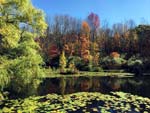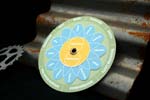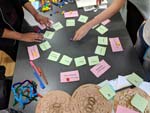
|

|
|
Home Site Search Contact Us Subscribe
|
|
Building Abundance #2: Three Keys to Abundant Design Hint: Designing for less bad won't get us there. Aiming for abundant design requires seeing and working in new ways that are largely unfamiliar, challenging - but oh so worth it! By Josie Plaut January 10, 2019 Editor’s note: This is the second in a series on abundance created and curated by Edward McGraw, AIA, LEED AP BD+C, founding partner and chief executive officer of Ashley McGraw Architects.
If we want to realize abundance, we can’t get there by conservation and reducing harm alone. To do so, we need to work from an entirely different paradigm – one that seeks to realize the potential of humans for becoming contributive and beneficial members of social and ecological communities.
Google Dictionary defines abundance as “plentifulness of the good things in life; prosperity.” Let’s play with that for a minute – what are the good things in life, anyway?
My short list of good things: Connection. Laughter. Purpose. Health. Beauty.
And life? Life, to me, is a fundamental capacity, instilled in and expressed by our planet, to regenerate and propagate a remarkable array of complex life forms and processes that are elegantly intertwined with the essential elements such as water, air, and nutrients. In short, life is pretty awesome.
Key 1: Working on abundance across scalesWe all strive to create value in our professional practice for our clients, our firms, and the communities in which we work and live. But how do we deepen that contribution to create authentic abundance across scales?
How might you evolve your practice to design for an abundance of the good things in life? How would you do this personally? With clients? With communities? With ecosystems? What capacities and capabilities would you need to develop to create abundance across all of these scales, simultaneously? Who would you need to become? What new understanding would you develop?
Key 2: Working with potential, not solving problemsDesign thinking asks us to spend considerable time identifying problems to ultimately shape the design solution. The trouble with this approach, ironically, is that it’s focused solely on problems! Unfortunately, conventional design thinking doesn’t focus on potential.
Warning: do not fall into the trap of thinking that potential is the same thing as seeing problems as opportunities.
Imagine asking a client to tell you about all of the problems and concerns they are facing with their space. This is an important question to help understand the functional aspects of their spatial needs, but it does not reveal potential.
Now imagine asking your client: What is the transformation you and your company are trying to realize in the world? What is the role that you are uniquely positioned to play within the context of your community and/or industry? What is the potential of this new or renovated space to generate abundance across scales?
By asking questions of this nature, with increasing degrees of depth and insight, we begin to shift the conversation from problem to potential. When we do this, our role as designers shifts, as well; buildings, and spaces can be more about the capacity and capability they enable – and also about the expression of identity, values, and purpose.
Key 3: ReciprocityThe third key to designing for abundance is reciprocity: elevating mutually-beneficial, co-evolving relationships.
How often have we mistaken reciprocity for self-satisfaction and/or self-benefit? How many times have we given a gift, a piece of advice – or a building – that was more about us than about the receiver? Or how often do we engage in a transactional way (i.e., if I produce a design, you pay me money)?
Reciprocity requires a deep understanding of and care for the other, which brings us back to working towards potential and scale. At its core, potential is based on the whole, unique essence of someone or something, and who/what they are trying to become. This is as true for you as it is for your clients, and even for the ecosystem that you both inhabit. Only through developing meaningful relationships with clients and communities, and by seeking to reveal and understand their inherent potential, can we have a chance of engaging in genuine reciprocity.
Designing from a new mindMuch of the sustainability and green building movements for the past 20+ years have focused on conservation of resources, reducing pollution, and minimizing waste – important work indeed. But efforts to conserve can only do so much on the path toward abundance. When we understand how to work from and with potential, and develop lasting relationships based on reciprocity across scales, then we are designing for abundance. Aiming for abundant design requires seeing and working in new ways that are largely unfamiliar and challenging – but oh so worth it!
Interested in learning more?Check out the new publication by CLEAR (Center for Living Environments and Regeneration) and the Institute for the Built Environment titled Becoming a Regenerative Practitioner: A Field Guide. CLEAR also has several free resources on the LENSES Framework and a number of programs and educational offerings focused on regenerative development and design. The Regenesis Institute for Regenerative Practice has a variety of publications and programs focused on the development of regenerative practitioners.
Josie Plaut is the associate director for the Institute for the Built Environment at Colorado State University and the executive director of CLEAR (Center for Living Environments and Regeneration). Josie’s professional role is focused on guiding teams through developing capacity and action plans for sustainability and regeneration. Her recent work for domestic and international clients includes high-performance buildings, master plans, district-scale urban redevelopments, and municipal programs, as well as work with community groups, companies, and organizations. She holds a bachelor’s degree in Sustainable Enterprise from Fort Lewis College and a Masters of Construction Management with an emphasis in Sustainable Building from Colorado State University. Josie is a founding developer of the LENSES Framework, a Paterson Center Certified StratOp Facilitator, and was an early Living Building Challenge Ambassador.
See also:
Creating abundance is more than sustainability or resilience, and should be a driving force in architecture. By Edward McGraw, AIA, LEED AP BD+C |
(click on pictures to enlarge)  Ashley McGraw Architects Google defines abundance as “plentifulness of the good things in life.”  Dusty Harms The LENSES (Living Environments in Natural, Social, and Economic Systems) Framework for Regenerative Development requires a comprehensive look at a site’s ecosystem.  Ashley McGraw Architects Aiming for abundant design requires seeing and working in new ways.  Dominique Hes Architects involve all stakeholders for the best sustainable thinking. |
© 2019 ArchNewsNow.com